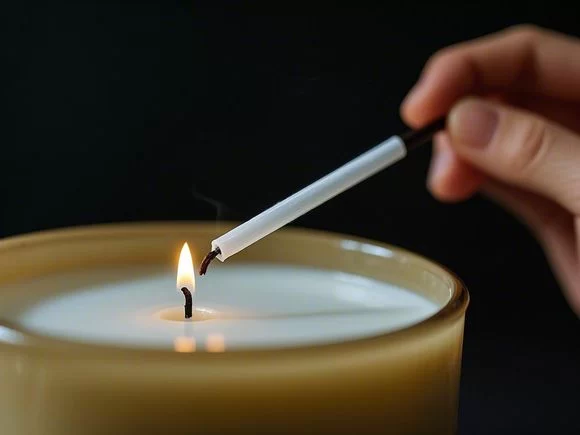What is the Ideal Wick Length for a Scented Candle?
- Introduction
- Why Wick Length Matters
- How to Determine the Ideal Wick Length
- Common Wick Length Issues
- How to Fix Wick Length Problems
- Conclusion
Introduction
When it comes to burning scented candles, the wick plays a crucial role in ensuring an even burn and optimal scent throw. However, many candle enthusiasts often overlook the importance of wick length. If your candle burns unevenly or produces minimal fragrance, the wick may be the culprit. In this article, we’ll explore the ideal wick length for a scented candle, why it matters, and how you can achieve a perfect burn every time.
Why Wick Length Matters
The wick length is a critical factor that directly affects how a candle burns. The right wick size ensures the candle burns evenly, provides an adequate flame, and distributes the scent evenly throughout the room. If the wick is too long or too short, the candle may burn too hot, too cold, or too quickly, leading to a waste of wax and suboptimal performance.
Impact on Scent Throw
Wick length also affects the scent throw of a candle. A properly sized wick ensures that the wax melts evenly, allowing for a stronger and more consistent fragrance release. Too short of a wick may not generate enough heat to melt the wax pool, limiting scent dispersion, while a wick that is too long can burn too intensely, potentially causing the scent to dissipate too quickly.
Safety Considerations
In addition to performance, the correct wick length is essential for candle safety. A wick that’s too long can cause a large, flickering flame, which can lead to uneven burning and even fire hazards. It’s important to maintain the wick length at an optimal size for both safety and effective burning.
How to Determine the Ideal Wick Length
Determining the ideal wick length for a scented candle depends on a few key factors, such as the type of wax, the size of the candle, and the type of wick used. Here are a few general guidelines to help you determine the best wick length:
1. General Rule: Wick Length Should Be About 1/4 Inch
As a general rule, it’s recommended to trim the wick to about 1/4 inch before lighting the candle each time. This length allows for an optimal flame size that’s neither too large nor too small. A 1/4-inch wick height helps to prevent soot and ensures an even burn.
2. Consider the Size of the Candle
For larger candles, you may need a slightly longer wick. If the wick is too short for the candle’s size, it may not burn evenly, leading to tunneling. On the other hand, smaller candles with short burn times typically require a shorter wick to prevent a flame that’s too large.
3. Test for Proper Flame Size
The ideal wick length will produce a consistent, steady flame. After lighting your candle, observe the flame size. If it’s flickering excessively or producing smoke, the wick may be too long. If the flame is too small and struggling to stay lit, the wick may be too short.
Common Wick Length Issues
Sometimes, even if you trim the wick properly, candles may still burn unevenly. Below are some common wick length-related issues and how they affect your candle’s burn:
1. Wick Too Long
If your wick is too long, the candle may burn too quickly, with an oversized flame that causes excess soot and uneven wax consumption. A large flame can also cause the wax to pool unevenly, leading to a burnt top layer while the rest of the candle remains intact.
2. Wick Too Short
A wick that’s too short will struggle to create an adequate flame. This can lead to tunneling, where only the center of the candle burns, leaving wax on the sides untouched. A short wick may also lead to a weak scent throw, as it doesn’t generate enough heat to melt the wax effectively.
3. Fluctuating Flame Size
If the flame flickers constantly or fluctuates in size, this could be a sign of an improperly sized wick, or it may be influenced by drafts. A steady, consistent flame is the goal for optimal burning.
How to Fix Wick Length Problems
Fixing wick length issues requires a combination of trimming, testing, and sometimes even adjusting the wick type. Here are a few tips to help address wick length-related problems:
1. Regular Wick Trimming
Trimming your wick to about 1/4 inch before each burn will help to maintain the correct flame size and prevent soot buildup. Always trim the wick when it’s cool to ensure safety.
2. Choosing the Right Wick for the Candle Size
If you’re making candles or purchasing candles, ensure that the wick is properly sized for the container or vessel. Larger candles generally require thicker wicks, while smaller candles benefit from smaller wicks.
3. Experiment with Wick Types
Different types of wicks, such as cotton, wood, or hemp, burn differently. If you’re encountering issues with an uneven burn, try experimenting with different wick materials to find one that works best with your specific candle.
Conclusion
Finding the ideal wick length for your scented candle is essential for an even burn, optimal scent throw, and overall safety. By understanding the importance of wick size and following the tips outlined in this article, you can ensure that your candles burn efficiently and effectively. If you’re looking for high-quality candles with perfectly sized wicks, visit Scent Snob for a curated selection of premium candles designed for the best performance.


0 comments